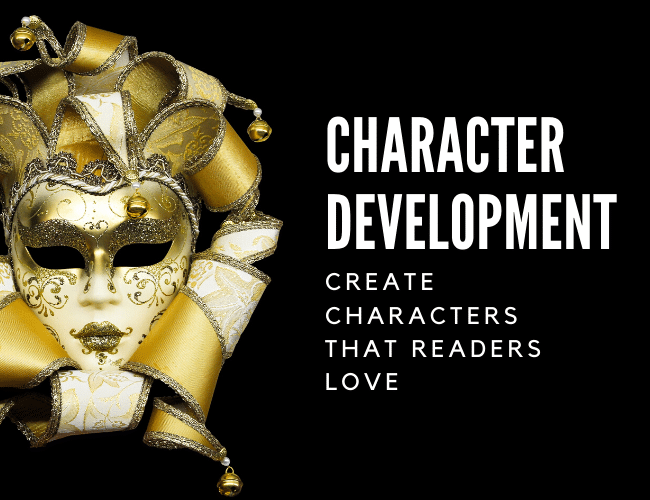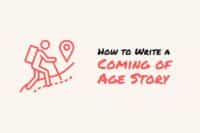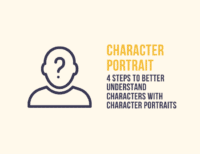Readers love great characters.
Think back to your favorite stories of all time. You might remember the story arc or not. You might remember the best bits of dialogue, or you might not. You might remember the setting descriptions, but let’s be honest, you probably don’t.
But the characters? Original characters? Your favorite characters? You’ll remember them for the rest of your life.

How do you create great characters? The short answer is character development, but what is character development and how can you use it to create characters readers love?
That’s what we’re going to talk about in this article. We'll start by discussing the definition of character development and why writers need to do it. We'll talk about each phase of the character development process, from creating to developing to storytelling with them.
Throughout, we'll look at lots of character development examples. Finally, we'll get you started writing with a character development exercise.
Here's a quick table of contents so you can jump to your favorite tips for character development in the article.
Table of Contents
Character Development Video Guide
What Is Character Development? 3 Steps
Types of Characters
How to Create a Character Sketch
6 Steps to Character Development Through a Story
Character Development Test
Character Development Writing Exercise
Character Development Video Guide
But first, would you prefer to watch this guide? Here's a video I made for it:
Make sure to like the video and subscribe to our channel for more videos about the writing craft.
Now, ready to get started with this characterization lesson? Let’s do it.
What Is Character Development? The 3 Steps to Well-Developed Characters
Character development is the process of creating and telling a story about a fictional character. It's far more than a personality trait list.
When it comes to compelling characters, there are only three steps:
- Create a character
- Develop the character (making them more sympathetic and/or villainous)
- Then, put them into a story
That's it. Easy right?
Actually no, it's not easy at all. You'll need to make hundreds of decisions to develop characters people can fall in love with. Each of these steps might take you days or months or even years.
Or they might happen in just a few moments.
J.K. Rowling said Harry Potter began when she had a vision of a young boy with a scar on his forehead board her train.
You might already have an idea for a character or a whole crowd of characters.
Of course, for Rowling it took her another five years to develop Harry Potter and write her first book.
And that's what we're talking about in this article: the process of taking ideas and turning them into living, breathing characters that can drive whole stories.
Let's begin with the first step: creating characters, as well as the different types of characters you might need to create.
Step 1: How to Create Characters for Your Story
Of all the character development steps, this is the one I have the least advice about. That's because characters are rarely created, they are discovered.
Before I came up with the idea for my last novel, I had a vision of a curly haired boy on a beach. I didn't know what my story was about by that point, but I knew it had to have him in it.
Just as J.K. Rowling discovered Harry Potter when he boarded her train, so most great characters come from a source that their writers have little control over.
You might come across inspiration in real life—real people who inspire you, but there are complex characters around you all the time in every movie, book, or story you read. Start noticing and you'll get a strong sense of what might inspire strong characters.
That being said, there are types of characters that you might need in your story, and if you know that you need that type, you can sometimes reverse engineer the characters.
Types of Characters
There are two broad categories of characters and many different subtypes:
1. Protagonists
2. Secondary Characters
Most stories only have one or two protagonists, or main characters, which means that most of your characters will be secondary characters. What is a protagonist?
Protagonist definition: The primary character of a story. The character at the center of the plot whose choices drive the story and whose fate determines the story’s outcome.
Protagonists tend to be dynamic characters who have a character arc that changes throughout the story. More on character arcs here.
Protagonists also tend to be point of view characters, meaning the narrator follows their point of view or they are a first-person narrator. (More on point of view here.) These characters carry the narrative, and in a story told in third person limited point of view, they will be the only character whose thoughts and emotions the reader can see.
Warning: Unless you're writing a love story, which frequently has two protagonists in the couple, be careful about having more than one protagonist. There's a reason George R. R. Martin is still (still!) trying to finish A Song of Ice and Fire. The more point-of-view characters you have, the more complicated your narrative, and the more problems you face.
There are three types of protagonists:
- The Classic Hero. Think Harry Potter, Jane Eyre, Atticus Finch, or Katniss Everdeen. Classic heros are brave, are selfless, and try to do the right thing.
- The Anti-Hero. Think Severus Snape, Huckleberry Finn, or Han Solo. Anti-heroes are not noble, rarely do the right thing, and might, in ordinary circumstances, be considered the villain.
- The Ordinary Hero. Think Neville Longbottom, Holden Caulfield, and Jane Austen's Emma Woodhouse. These characters have an even mix of admirable and less noble qualities, just like most of us.
Which type is your protagonist? Let us know in the comments. Also, read more on the three types of protagonists in this guide.
Secondary characters are the next category, and they contain all the other types of characters, including:
- Villain or Antagonist. Not every story has a villain, but for the ones that do, the villain is the chief source of external conflict.
- Love interest and love rival. In stories with a love plot or subplot, the love interest is the chief love interest for the protagonist and may even be a protagonist themselves. They may be static, meaning they don't change over the course of the story, or dynamic, meaning they do change, but they add to the romantic tension. Similarly, most love stories involve rivals, another love interest who creates a love triangle and increases the romantic tension.
- Foil Character. A secondary character who acts as a mirror to the protagonist and is often very similar but different in one major way that allows us to better understand the protagonist's personality and choices.
- Mentor. The mentor is a character who steers the protagonist, helps get them out of trouble, and provides chances for reflection. A mainstay of the hero’s journey plot structure, in many types of stories, without a good mentor, the character’s journey will end in tragedy (e.g. think about Hamlet, who had no mentor).
- Sidekick. A sidekick is a character who supports the protagonist. Besides the protagonist and villain, they have the most opportunity for characterization and provide dialogue opportunities and insight into the character’s mindset. Sidekicks appear in all genres, from romance (e.g. Mercutio from Romeo and Juliet) to adventure (e.g. Samwise Gamgee from Lord of the Rings) to mystery (e.g. Inspector Beauvoir from the Inspector Gamache series) and more.
- Side Characters. Side characters often have fully developed personalities, long interactions with the protagonist, and perhaps even deep backstories. However, they rarely make decisions or change throughout the story.
- The Chorus. A term from playwriting, these characters may have names and vague descriptions, but they do not have fully developed personalities and are chiefly there to serve as bystanders.
- Suspects. Specific to mysteries and thrillers, suspects have fully developed personalities and they serve as objects of exploration for the investigator. They should all have motives and appear at least somewhat guilty of the crime, if only to serve as red herrings.
These tend to be static characters with a flat character arc, at least within the confines of the story. However, great writers know that all characters have their own arc. Your job as a writer is to choose how much of that arc to show the reader in the story.
For more on each of these character types, check out our guide, 6 Character Types Your Protagonist Needs Around Them.
Step 2: Develop Your Characters by Making them More Sympathetic (and/or Villainous)
Once you have a few characters, your work is not done. Now you have to develop them.
To do that, I've created a framework called the Seven Characteristics of Sympathetic Characters.
I learned this from Brandon Sanderson's fantastic characterization lessons as well as Blake Snyder's Save the Cat and my own research into story structure and characterization.
These characteristics are reader candy. We love characters with these personality traits, and by adding them you can quickly create a bond with your readers.
Think of this list as a checklist. The key is to include at least two or three of these characteristics early in your story, ideally in your protagonist's first scene.
This list also works for your secondary characters, and it can be used to quickly add depth and connection.
For your villains and antagonists, you can use this list in the opposite way, making the audience dislike them or even combining negative traits with sympathetic ones to give us a truly round, dynamic villain.
Here are the characteristics:
7 Characteristics of Sympathetic Characters
Use these seven traits to create believable characters who connect with the audience:
- Takes action. Show your protagonist being proactive. Show them making a hard choice when faced with a dilemma and taking action to get what they want.
- Treated unjustly. Show your character being bullied, persecuted, treated unfairly, or as the victim of injustice. One easy way to do this is to make your character an orphan, a trait shared by Hamilton, Harry Potter, nearly all of Charles Dickens's protagonists, Anne of Green Gables, Mark Twain's Huckleberry Finn, and many more iconic characters.
- Shows competence. Readers are interested in people who have competence, who show off their skill (even if those skills are unusual).
- Has friends. We’re attracted to people who show that they already have other people who like them. Just having a friend makes us more interested in someone. Show your protagonist is likable by surrounding them with other interesting characters.
- Does a good deed. “Save the cat,” as Blake Snyder says. By helping someone in need, your protagonist establishes themselves as “the good guy,” despite any other negative qualities.
- Has a humanizing quirk. Quirks are memorable things that create an instant visualization of someone, like Harry Potter’s scar on his forehead, Ron Weasley’s bright red hair, or Hermione’s frizzy hair. These can also include distinctive mannerisms, like a speech pattern, unique voice, or habits. Humanizing quirks are especially important for side characters, but a simple quirk can be a shortcut to help us quickly get to know a protagonist.
- Secret vulnerability. Everyone has a secret, whether it’s a phobia like Bruce Wayne’s fear of bats, Superman’s weakness toward kryptonite, or Inspector Gamache’s terror of heights. By letting the reader in on your protagonist’s secret vulnerability, you create a bond that can last the entire story.
Once you've picked two or three of these that fit your character, include them in your early scenes. You can also include these throughout your story to make us fall in love with your character even more.
How to Create a Character Sketch
Once you've picked the traits, you can create a character sketch or character profile. This is where you record details about a character to remember for the writing process or continue to develop them.
I’ll summarize the process below, but for a full guide, you can read about how to create a character sketch using Scrivener, one of our favorite writing tools, here.
You can mix and match elements to create your own character sketch template, but here’s what a character sketch might contain:
- Character name
- Photo (I just find something on Google image search to serve as a likeness)
- Character type (see 8 types below)
- One sentence summary
- One paragraph description (including a physical description, occupation, flaws, good attributes, and mannerisms)
- Goals (what do they want)
- Conflicts (what keeps them from getting what they want)
- Narrative (what do they do in the story)
Remember, the best way to do character development is to throw characters into a story. Don’t sketch characters for their own sake, but to find where they fit into the story.
Character Development Questions: 78 Questions to Ask Your Characters
Another development technique is to interview your characters, imagining them sitting before you, asking them a series of questions, and imagining their response.
You can invent your own questions, but there are also established lists of questions that have been used by writers for decades. Here are three helpful lists that, together, total seventy-eight questions:
The Proust Questionnaire. Used by novelist Marcel Proust when he was just fourteen years old, this questionnaire includes thirty-five questions that writers have used to find out who their characters are.
37 Questions to Ask Your Character. This list of unique and often surprising questions will help you discover many different sides of your character. Here's an example: “What did you eat for breakfast? Did you make it yourself? What time do you eat breakfast? Do you wash the pan after you cook the eggs or do you leave it for the maid to clean? Do you have a maid?” We first published this list by Pamela Hodges in 2016 and since then it's been shared over 6,000 times!
6 Revealing Questions to Get to Know Your Protagonist. This one is especially helpful to get to know your protagonist.
Try one or more of these lists and see if it helps you get to know a new side of your character's personality.
Step 3: Throw Your Character Into Your Story
This is the most important step, and one that many writers take far too long to get to.
Some writers believe they have to know every aspect of each of their characters personality before they start writing their book, from their earliest memories to their favorite afternoon snack.
However, this is often a waste of time. Why? Because your job as a writer is to put your character into stressful, high-conflict situations, and in those moments, their favorite afternoon snack is going to be the furthest thing from their mind!
That isn't to say you shouldn't spend some time getting to know your characters. Just recognize that's just the beginning. The real character development begins when you start telling your story.
6 Steps to Character Development Through a Story
Character arc and story arc are usually the same thing. By telling a great story, your character will change and transform.
This arc follows the six elements of plot, which we go into detail in this in our plot structure article, but which we'll summarize here:
1. Exposition. Begin with the character's “normal.”
What does “normal” look like for your protagonist? In about one-half to no more than three scenes, show what normal looks like for your character.
2. Inciting Incident. A problem or opportunity interrupts the character's status quo.
In the inciting incident, something interrupts the character's normal life and forces them to respond.
For example, Harry Potter receives an admissions letter from Hogwarts. A dead body is discovered in three pines, leading to a call to Inspector Gamache. William Wallace's wife is killed by the English. The devil appears to Dr. Faustus offering him a deal.
3. Rising Action/Progressive Complications. Problems and complications increase, causing conflict for the protagonist.
As the story continues, things must get more and more challenging for the protagonist. Maybe they're getting better, maybe they're getting worse, but they're definitely getting more complicated.
Here it's useful to remember the century-old writing advice:
In the first act, put your character up a tree. In the second act, throw rocks at them. In the final act, bring them down.
This is the rock throwing part.
But as you increase the internal conflict and external conflict, your character will develop right before your eyes. You may discover new aspects to their personality you had no idea about as you watch how they handle adversity.
4. Dilemma. Give your character an impossible choice.
The purpose of the rising action is to put your protagonist into an impossible choice, a dilemma where they have two equally difficult choices.
I find this moment in Frozen to be a useful example for this (spoiler alert if you somehow haven't seen Frozen!):
Princess Anna is moments away from freezing solid. The only thing that can save her, she thinks, is true love's kiss from Kristoff, who is racing toward her. However, at the same moment, she sees Prince Hans about to kill her sister. What does she do?
- Option A: Save herself, continuing toward Kristoff but allowing Elsa to die
- Option B: Save her sister, choosing to stop Hans but sacrificing herself in the process
An impossible choice. But it's dilemmas like this that are the engines of great stories and great characters.
5. Climax. The protagonist makes their choice and high conflict and action follows.
The protagonist chooses and the result of their choice leads to the moment of highest action and conflict in the story. Remember, conflict in fiction directly impacts your character development.
This choice is so essential because it truly tests and reveals their character. Don't skip it!
6. Denouement. The protagonist's new normal is established.
What does the character's new normal look like after going through the conflict and drama of the story?
This is a moment, usually just one scene, where we get to enjoy and bond with the character for a final time before the story ends.
Character Development Test: What Makes a Good Character?
On my podcast, Character Test, my cohost and I have found that there are four criteria that you can use to evaluate a character, to test and see whether a character is good or not.
Here, I’m not talking about whether they are morally good, but whether they are interesting, relatable, entertaining, and worth following. In other words, this is about figuring out will readers love them.
Also, this is what makes a good character. If you want to know how to make a good character, scroll down to the Character Development Steps section.
1. Good Characters Have Goals
Good stories are about characters who want something, and they experience challenges to get what they want.
Desire is central to good stories, good characters, and to the human condition itself. Good characters have deeply held desires and are willing to make sacrifices to achieve those desires.
That being said, those desires don’t have to start out as anything big.
As Kurt Vonnegut said, “Make your characters want something right away even if it's only a glass of water. Characters paralyzed by the meaninglessness of modern life still have to drink water from time to time.”
2. Good Characters Face Challenges to Their Goals
As nice as it would be for your character to get everything they wanted without having to do any work, it would make for a very boring story! This is part of the conflict we discussed above.
I like what best-selling author Kristina McMorris told me: “I only give my characters a happy ending if they’ve worked really hard for it.” Kristina’s novel Sold on a Monday was on the New York Times Best Sellers list for twenty straight weeks, so she knows what she’s talking about!
3. Good Characters Make Decisions
Good characters take control of their own fate. They take action. They make choices, and they suffer the good or bad consequences of those choices.
Bad characters let life happen to them. Bad characters allow others to make choices for them. They never take action in their own lives, and it’s their lack of decision-making ability that makes them boring.
4. Good Characters Are Empathizable
I made this word up, but I think it’s going to stick!
Editorial note from Alice: Stop trying to make “empathizable” happen, Joe. It's not going to happen.
You can empathize with good characters. Even if they are villains (especially if they’re villains), you can understand where they’re coming from, and maybe even relate.
Good characters, in other words, are human.
Bad characters are so foreign or perfect or evil that you can’t relate to where they’re coming from.
Bonus: Good Characters Change . . . Sometimes
Many will argue with this, but not all good characters change. In fact, you can tell a great story where the protagonist doesn’t change.
Take James Bond. In a few novels and films he changes (e.g. Casino Royale) but in most, James stays the same stoic, cocky person he started out as. And the novels are still great!
Or Inspector Gamache, my favorite detective from the series by Louise Penny. Inspector Gamache starts out as the perfect gentleman, thoughtful leader, and unerring investigator and ends each novel the same way. There are a few individual books where he goes through deep inner turmoil, but even then he re-emerges the same amazing person, just a little bit stronger and surer in his ways.
There are many great stories where the character changes. It’s especially a hallmark of the hero’s journey (which is itself a form of character development). But it’s not always a requirement of a good character.
Character Development Writing Exercise
Now that you know everything about developing characters, let's put your new knowledge to practice! Use the creative writing exercise below to practice bringing your characters to life!
And if you're to create a character sketch for your novel, check out our guide on how to create a character sketch with Scrivener.
Good luck and happy writing!
What is your favorite characterization tip above? Are there any I missed? Let me know in the comments.
PRACTICE
Let’s put your character development to use with this creative writing prompt:
- Choose one of the character types above and spend five minutes sketching out their character using the character sketch template above (Character Name, type, one-sentence summary, goals, conflicts).
- After your five minutes are up, write about your new character as they go through a scene using the character development steps in a story: desire, conflict, dilemma, choice, and change. Write for ten minutes.
When your time is up, post your practice in the Pro Practice Workshop. And if you post, be sure to give feedback to at least three other writers.
I'm looking forward to meeting your characters!










I write & file pieces about my characters (main & major secondary) & for the main ones, may return to them several times. There are lots of folks in my novels, good guys & bad, so at some point I also write a for-file piece on which other characters are their ‘shadows’…even antagonists have feared antagonists. The first files help me bring them to life in my head, so I can monitor their behavior. The shadow file is important to off-main-plot resolutions. In truth, I seldom go back to my original files…having written them is usually enough. I’m on the last 40-50ppg of a novel draft right now…so there are over a dozen people living (& interacting) in my head. It’s around this point in the process that I begin muttering to myself that my next book is going to be 500 very short personal essays!
Good one, Emily. I’m going to review my work-in-progress with these notes in mind. Thank you. I have one guiding principle, and that is — what will cause my protagonist to utterly fall apart. Because that’s where my stories have to go. Whatever will bring my character to a radical change of heart. All those things you mention are key to that happening. Cheers. ~ PJ
The four Questions: Diana Daughter of Darkness
My character Diana, is from the kingdom of Firefall and is it’s princess. All Diana wants is to find her father and get justice for her mother’s untimely death. But she finds herself haunted by her destiny more and more as she tries to achieve those goals. Diana’s relationship with her father is the most outstanding in the book but her relationship with her handmaiden and the two boys she grew up with are also very important to her. Diana’s biggest fear is failure. She doesn’t want to fail her father or her Kingdom. The power inside of her grows every day but she fears that it will soon take over her and leave nothing but destruction in it’s wake. This is perhaps what scares her the most…herself.
Emily,
Some good tips. My character questionnaire is at least 100 questions long and I often take characters to lunch—or let them take me to lunch.
But I like your four tips for character development. They get to the heart of things quickly and provide an excellent framework for more complex development if that’s what a writer wants to do.
I’d like to add one suggestion.
A character’s worldview plays a major role in the way he or she responds to life in general and to individual incidents. A person who believes life is the result of time plus matter plus chance generally behaves differently than someone who believes they were created for a purpose.
All five factors–your four and my addition–contribute to the development of person’s personality and behavior.
Thanks again for the excellent tips. I’ve been away for several weeks polishing my own novel. This was a wonderful way to get back into the routine.
Great tips, Emily!
I’ve found that writing side stories about my characters helps me to explore who my characters are. I’ll make up a scenario, drop a character in the middle of it, and then give them free reign. This practice helps me flesh out how they make decisions and how they interact with the other characters in my story. Plus, it’s just fun to do!
Amy
Awesome article.
The article was extremely helpful it gave me ideas of how to strengthen my short story.
My character is about a teenage girl that has strong family values due to her upbringing in a strict home where her mother is the head of the household, suddenly her mother dies she fills empty and alone, as all of her siblings are grown they have there own children. She start’s to explore the world and gets caught up in it.
Emily,
Excellent tips, especially number 3. People often understand themselves through their relationships with others. How they’re greeted, how they’re treated, how others understand their humour, their moods, their needs and wants. To understand a person’s key relationships, and what they’re willing to do for the people they love (as you say), means understanding what makes them tick.
I also liked the point you made in Q4. Our fears sometimes reveal our true nature, in that they are a direct consequence of our values. In your example, Katniss fears being forced to kill others, because she values life and humanity. Our values sets us apart.
Great tips, thanks for sharing Emily. I think what a person wears says a lot about his/her personality. So that’s where I often like to start:
On the door stood a mid-aged woman in a black coat reaching down to her knees, a red scarf around her neck and a winter cap that covered most of her luscious brown hair. She had a book in her hand that she kept between her palms. Every now and then she would flip it open, read a few lines before closing it again and stare back at the meadow beyond her porch. It seemed as though she was deep in thought, and I afraid of interrupting stood still waiting for her to look back and notice my presence.
Nice post! Number 2 is the most important, but # 3 is the one I need to spend more time on. I never really even considered that with character development, and now I’m kicking myself because it’s such an important aspect of creating a “real” person in your character.
Thanks for the tips, Emily. I believe #2 is the most critical one since it will somewhat define who your character is. I’d like to share another article on character development that I hope could be of help to others. Here’s the link: https://www.chatebooks.com/blog-Character-Development-that-Entices-Readers
Awesome 🙂
Finally something that helps developing characters other than long ass questionnaires, interviews or worksheets that became too tedious to do.
Thanks for this article, Emily! I never thought with only 4 questions I’d be able to come up with a set of believable characters. I’ve always had a long line of questions just to have a concrete description of what and how my characters would look and sound like. I’d like to share an article I found on character development. Hope this could help as well: https://www.chatebooks.com/blog-Character-Development-that-Entices-Readers
My character is a teen-aged girl brought up by a young, single mother who has had to work very hard to take care of her child. The girl doesn’t want to make things harder on her mother and tends to smile a lot and pretend everything is just fine, even when it’s not. Her relationship with her mother and the lack of one with her father shapes many of her views from romantic relationships to political ideology. Her greatest fear is to not end up as someone her mother can be proud of raising. Another quirk is her fear of sharing her feelings with others.
For starters, Joe, I find you tremendously empathizable and vow to fully support you should you take action to replace your foil character, Alice, with someone equipped with a bit more imagination and a lot more humor.
Jokes aside. This article is a gem. I am not a writer, definitely not a great storyteller and do not come with an endless supply of creativity, however, I take great joy in writing, especially when inspired. I have found that when I share my “pieces,” that something tends to draw people into my creation (much to their and my surprise!).
So, as of, oh, about three hours ago, I made the decision to give it a more serious try and actually write something more substantial and less silly than Local Google Guide reviews. But to be any good at most anything, research is a must! I have about thirty tabs open, ready to be inhaled, masticated, repeated, digested and possibly incorporated in my book of writing “recipes.” Roughly ten of those tabs are direct links from your articles and I am starting to wonder if I’ll be able to find a good stopping point or if I’ll just lose myself in the world of creating worlds.
Not to worry! I do come equipped with a stubbornness factor and, if anything, your guidance has served to exponentially “peak” my interest. Many thanks! And please do something about that editor. 🙂
Warm regards,
Joana (Jo)